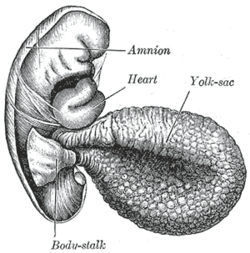Body-stalk
| Body-stalk | |
|---|---|
 Diagram showing the expansion of amnion and delimitation of the umbilical cord | |
 Section through the embryo | |
| Details | |
| Latin | Pedunculus truncalis |
The body-stalk, also known as the allantoic stalk,[1] is a band of mesoderm that connects the caudal end of the embryo to the chorion in development. With the formation of the caudal fold, the body-stalk assumes a ventral position; a diverticulum of the yolk-sac extends into the tail fold and is termed the hind-gut. With continued development, the body-stalk is later replaced by the umbilical cord.
Body stalk anomaly occurs in approximately 1 in 15,000 births.[2] It is a result of defects in the formation of cephalic, caudal, and lateral embryonic body folds.[3]
Additional images
-

Human embryo—length, 2 mm. Dorsal view, with the amnion laid open. X 30.
-

Human embryo of 2.6 mm.
-

Diagram showing later stage of allantoic development with commencing constriction of the yolk-sac.
-

Model of human embryo 1.3 mm. long.
-

Section through ovum imbedded in the uterine decidua.
-

Embryo between eighteen and twenty-one days.
-

Human embryo about fifteen days old. Brain and heart represented from right side. Digestive tube and yolk sac in median section.
References
- ↑ Arthur Robinson (1913). Cunningham's Textbook of Anatomy. William Wood. p. 54.
- ↑ Asim Kurjak (30 June 2013). Donald School Textbook of Transvaginal Sonography. JP Medical Ltd. p. 28. ISBN 978-93-5090-473-2.
- ↑ Diana W. Bianchi; Timothy M. Crombleholme; Mary E. D'Alton (1 January 2000). Fetology: Diagnosis & Management of the Fetal Patient. McGraw Hill Professional. ISBN 978-0-8385-2570-8.
External links
- Swiss embryology (from UL, UB, and UF) hdisqueembry/triderm0